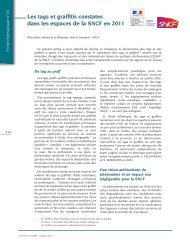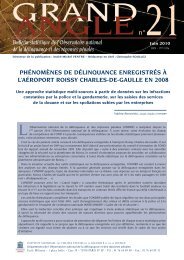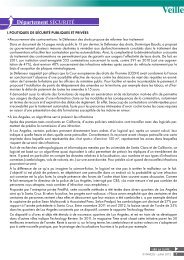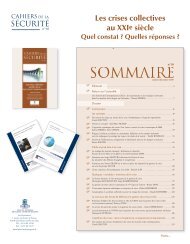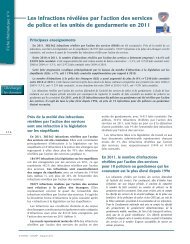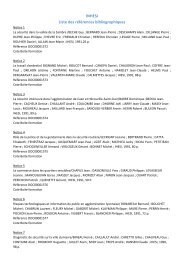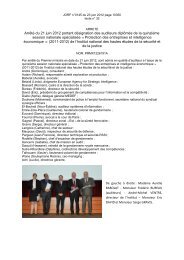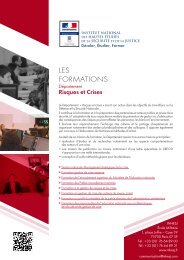Télécharger le PDF - inhesj
Télécharger le PDF - inhesj
Télécharger le PDF - inhesj
You also want an ePaper? Increase the reach of your titles
YUMPU automatically turns print PDFs into web optimized ePapers that Google loves.
La mode cib<strong>le</strong> privilégiée<br />
de la contrefaçon<br />
Corinne CHAMPAGNER KATZ<br />
La contrefaçon est un fléau économique qui atteint l’ensemb<strong>le</strong> de la filière de la mode (matières premières,<br />
Haute Couture, prêt à porter, lingerie, chaussures, bijoux, sacs …). Sept millions d’artic<strong>le</strong>s saisis en France en 2009.<br />
La mode est un secteur particulièrement touché puisqu’el<strong>le</strong> représente 34% des contrefaçons 1 . Tous <strong>le</strong>s acteurs<br />
économiques de la filière sont concernés. Les droits de Propriété intel<strong>le</strong>ctuel<strong>le</strong> atteints sont <strong>le</strong>s marques, <strong>le</strong>s<br />
dessins et modè<strong>le</strong>s et <strong>le</strong>s droits d’auteurs. Les actes de contrefaçon entrainent au détriment des entreprises une<br />
perte de parts de marché et consécutivement une perte de chiffre d’affaire. La contrefaçon nuit à l’image de<br />
marque et « néantise » <strong>le</strong>s efforts de création. Internet a amplifié <strong>le</strong> phénomène et représente un lieu d’action<br />
confortab<strong>le</strong> pour <strong>le</strong>s contrefacteurs. Les produits contrefaits peuvent être vendus via une plateforme e-commerce,<br />
permettant aux cyber-contrefacteurs de protéger plus longtemps <strong>le</strong>ur anonymat. Dans <strong>le</strong> domaine de la mode, <strong>le</strong><br />
consommateur est particulièrement lésé par la cyber-contrefaçon dans la mesure où <strong>le</strong>s critères qualitatifs d’un<br />
produit tels que <strong>le</strong>s matières premières et la coupe des produits, ne peuvent pas être contrôlées avant achat et<br />
distribution. Ces constats ont mené à de nombreux accords de coopérations internationa<strong>le</strong>s (comité mixte<br />
franco-italien de lutte contre la contrefaçon 2 , <strong>le</strong> comité-franco russe 3 , l’accord bilatéral franco-chinois sur la lutte<br />
anti-contrefaçon 4 etc.). À titre d’exemp<strong>le</strong> récent, c’est en partie grâce à sa collaboration avec <strong>le</strong>s autorités<br />
chinoises que la société J.M Weston, spécialisée dans la fabrication de chaussures de luxe, a obtenu <strong>le</strong> 20<br />
décembre 2010 la fermeture d’une usine qui contrefaisait la marque éponyme.<br />
Fashion is the historic and prime target for counterfeiters<br />
Counterfeiting, fake imitations and copies are a major economic headache for the who<strong>le</strong> fashion sector; raw materials,<br />
the Haute Couture fashion houses, readymade clothes, lingerie, shoes, jewel<strong>le</strong>ry, handbags etc. Seven million counterfeit<br />
artic<strong>le</strong>s were seized in France alone during 2009. The fashion industry is particularly hard hit, counting for 34%<br />
of all fake products. All economic actors in the sector are affected. Intel<strong>le</strong>ctual property rights are consistently violated<br />
concerning brand names, trademarks, designs, models and copyright.This type of counterfeiting means that companies<br />
lose market share and consequently see sa<strong>le</strong>s reduced. Counterfeiting damages a brand's image and destroys creativity.<br />
The Internet has amplified this phenomenon and has become a comfortab<strong>le</strong> media for counterfeiters. Copies, fake<br />
imitations and counterfeit products can easily be sold from an e-commerce platform. Furthermore, the internet can<br />
maintain a cyber-counterfeiter's anonymity for much longer periods. In the fashion industry, consumers are at a particular<br />
disadvantage with cyber-counterfeit products. Quality controls, obviously, do not exist prior to purchase and distribution.<br />
There is, therefore, no way of knowing whether the raw material and cut of a garment will be as expected. These prob<strong>le</strong>ms<br />
have <strong>le</strong>d to the creation of a number of international agreements: such as the French-Italian Mixed Committee in the fight<br />
against counterfeit products; the French-Russian Committee; the French-Chinese Anti-Counterfeiting Bilateral Agreement<br />
etc... A recent examp<strong>le</strong> of such collaboration concerns the luxury shoe manufacturer J.M. Weston. After working closely<br />
with the Chinese authorities, on 20th December 2010, they obtained the closure of the factory manufacturing counterfeit<br />
products under their name."<br />
Corinne Champagner Katz<br />
Avocat au Barreau de Paris. Spécialiste en droit de la propriété intel<strong>le</strong>ctuel<strong>le</strong>. Consultante en intelligence<br />
économique. Auditrice de la 16 e session à l’Institut National des Hautes Études de Sécurité. Lieutenant Colonel de<br />
la Réserve Citoyenne de la Gendarmerie Nationa<strong>le</strong>.<br />
(1) http://www.budget.gouv.fr/actus/suite/100921_faux_du_logis.htm<br />
(2) Comité franco-italien de lutte contre la contrefaçon crée en 2002 et co-animé coté français par l’INPI et la DGDDI<br />
(3) Comité franco-russe pour la propriété intel<strong>le</strong>ctuel<strong>le</strong> et la lutte contre la contrefaçon créé en 2001 sous <strong>le</strong>s auspices du Conseil<br />
économique, financier, industriel et commercial franco-russe (CEFIC)<br />
(4) Accord franco-chinois sur la lutte anti-contrefaçon signé à Pékin <strong>le</strong> 7 juil<strong>le</strong>t 2009 entre <strong>le</strong> CNAC (Comité national anti-contrefaçon)<br />
et l’administration chinoise<br />
54<br />
Accès sommaire



